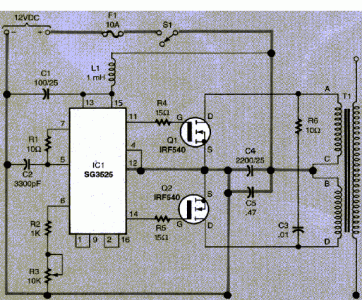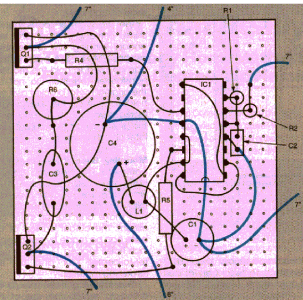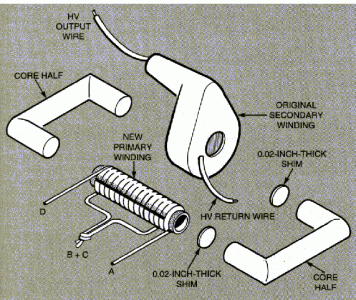High frequency plasma circuit (Electronic Ion Pump)
This circuit utilizes a flyback transformer that has wire windings added to its ferrite core. The high-voltage, high frequency is the result of the transformer being driven into resonance at 20 to 170Khz. The flyback transformer supplies high-voltage, high frequency. Its output is in harmony with the Sea of Energy that surrounds it. Like the waves of the ocean, coming and going in regular beat notes, it is in tune with the radiant energy that surrounds its output. This source can be used to excite the Nu Energy Fuel Cell™ into producing electrical power or “proof of concept” radiant energy circuit. Robert E. Iannini designed this circuit. This circuit may be purchased from Information Unlimited. It is item #TCL50. A less expensive circuit may be built. Click here for online diagram.
The flyback (T1) has two added primary coils to its ferrite core that are driven by two Mosfet (Q1 & Q2) in a push-pull configuration. Full core saturation occurs with this design that reduces strain on the Mosfets as they run fairly cool even at 5 to 7 amps of current draw. A clock circuit (I1) generates synchronous signals 180 degrees out of phase with internal duty time. The frequency is variable with control pot (R3). This allows fine-tuning of the frequency, driving T1 out of resonance where it can reduce over-all output voltage from the flyback for various adjustments. Capacitor (C2) and R3 determines the drive frequency to the primary windings. Resistor (R2) sets the duty time for smooth operation. Inductor (L1) and capacitor (C1) uncouple the Mosfets and clock circuit I1. Resistor (R4) and (R5) eliminates parasitic oscillation that could occur on the gates of Q1 & Q2. Resistor (R6) and C3 form a snubber network to absorb any leakage energy that may be generated by inductance T1. This is to prevent the Mosfets from quickly breaking down if high-voltage spikes occur in the network. C4 and C5 by-pass any high-frequency that could appear at the primary center point of T1.
This circuit draws maximum 5 to 7 amps when properly tuned. I use a small 12-volt direct current (dc) computer processing unit (CPU) fan, that is normally used in personal computers, to cool the flyback transformer.
Assembly
- Spread out and identify electronic components and hardware. Confirm resistor values by using resistor color codes.

- Insert and solder all electronic and electrical components onto a 2-inch square piece of perforated construction board. The blue wires are 20-gauge to carry 5 to 7 amps of current.

- Parallel wind 15 turns of 18-gauge magnet wire onto a plastic 1½-inch long, ½-inch inner diameter plastic tube. Connect one wire from the top of one of the coiled wires to the bottom end of the opposite coil, this is your B & C connection. Then wrap these coils tight with electrical tape. Carefully separate the flyback transformer’s two core halves. Add 0.02-inch thick shims (business card thickness) between the core halves then reassemble. Use hot-glue or equivalent glue to hold the cores in place.
- Mount Q1 & Q2 onto transistor heat sinks.
- Recheck all wiring according to the schematic.
Test Circuit
- Turn R3 fully counter-clock-wise, switch S1 to off, insert 10 amp fuse into it’s holder.
- Connect the negative probe of an amp-meter to supply ground. The positive probe is connected to the negative terminal on a twelve-volt power supply.
- Now connect the positive terminal on your power supply to the positive input of the high-voltage, high-frequency inverter circuit.
- Next, turn on power switch S1, notice a reading of 1 amp on your meter. Slowly adjust R3 clock-wise and there should be a rise in your reading to about 2 amps. You should also see some ion glow around the output terminal. This is the lowest operational output that this circuit put out and can be used continuously in this mode without overheating. Continue to turn R3 and you should then notice a sharp rise in your reading. This is the maximum operational mode and you should be reading around 7 amps. Do not continue to operate in this mode as the flyback can become quickly damaged without being cooled.
- You can enclose the flyback in a 6-inch PVC tube. Seal around all wire feeds using silicon sealant. Use PVC plumber’s cement to seal tube pieces. Make sure that your circuit is functioning properly before making final seals.
- You can fill the PVC with mineral oil to the top of T1. You do not need to seal the top cap if you are using the unit in its upright position. You can also eliminate the extra weight of the oil and its associated mess by cooling the flyback with a small 12-volt dc personal computer processing unit (CPU) fan.
- The output of the flyback is terminated to a suitable hardware bolt.
Parts List
Resistors
All resistors are ¼-watt, 5 % tolerance, unless otherwise indicated
- R1-10-ohms
- R2-1,000-ohms
- R3-10,000-ohms potentiometer
- R4, R5-15-ohms
- R6-10-ohms, 3-watt, non-inductive
Capacitors
- C1-100-µF, 25-WVDC, electrolytic
- C2-3300-pF, 50-WVDC, polyester
- C3-0.01-µF, 2KV, ceramic-disc
- C4-2200-µF, 25-WVDC, electrolytic
- C5-0.47-µF, 250-WVDC, polyester
Semiconductors
- IC1-SG3525A pulse-width modulator, integrated circuit-Silicon General
- Q1, Q2-IRF540 MOSFET
Miscellaneous: electrical
- S1-SPST 7-amp switch
- T1-Modified flyback transformer -see text
- L1-1-mH choke coil
- F1-10-amp fuse & fuse-holder
- Heat sinks & mica insulators for Q1 & Q2
- 20-gauge wire
- 18-gauge wire
Miscellaneous: hardware
- 2-inch square perforated construction board
- 2-3-inch flat PVC end caps
- 6-inch length of 3-inch diameter PVC tube
- Mineral oil or 12-volt dc mini fan
Warning!!!
Electricity is EXTREMELY DANGEROUS and caution should always be used when working around it. Please take the time to educate yourself sufficiently. If you don’t understand something, investigate further before attempting. Take liberal advantage of encyclopedias, science books, and other reference materials. This file was compiled for information purposes only. We do not control the materials used in construction, the methods of construction, nor the applications of the construction, therefore; WE ARE NOT RESPONSIBLE FOR DANGEROUS OR UNDESIRABLE RESULTS. Always use rubber gloves when working with high-voltages.
ALL SAFETY PROCEDURES MUST BE CAREFULLY OBSERVED
MEASURING THE HIGH VOLTAGE IS NOT RECOMMENDED
Disclaimer: The author assumes no liability for any incidental, consequential or other liability from the use of this information. All risks and damages, incidental or otherwise, arising from the use or misuse of the information contained herein are entirely the responsibility of the user. Although careful precaution has been taken in the preparation of this material, we assume no responsibility for omissions or errors.










